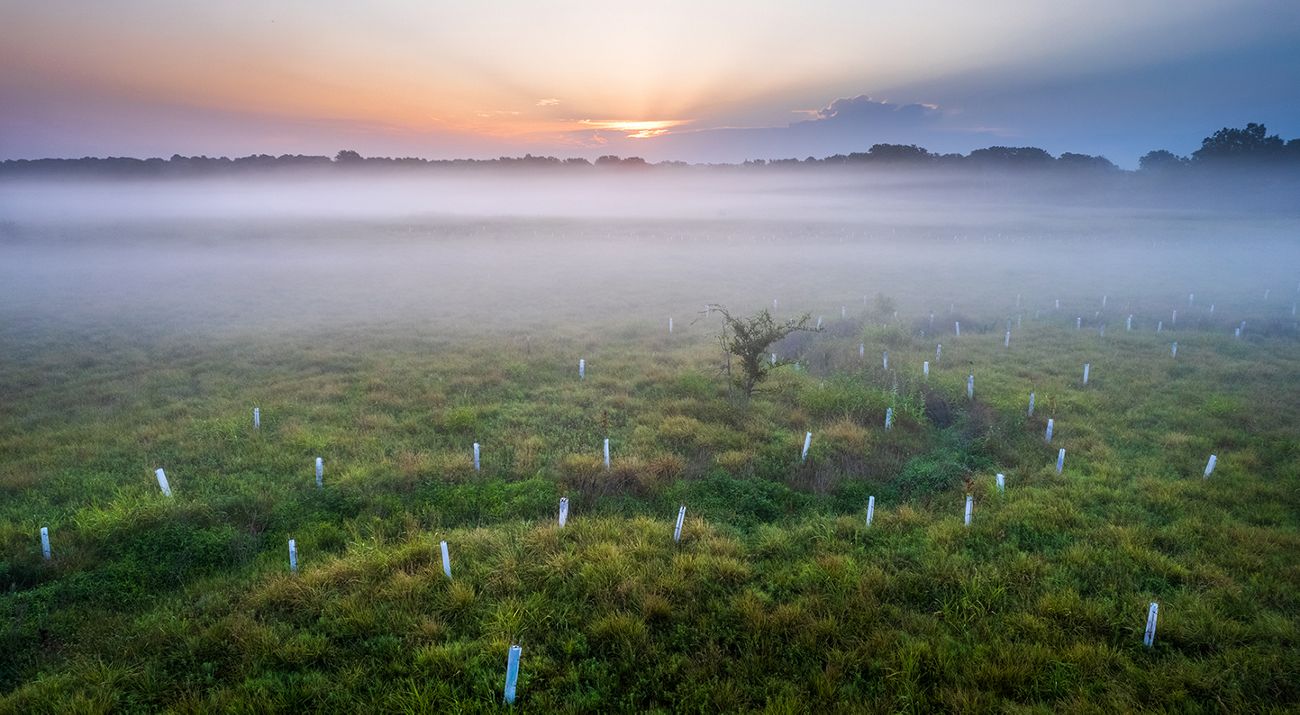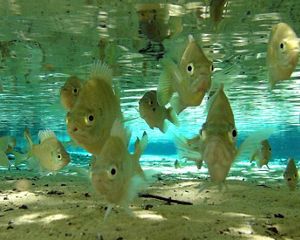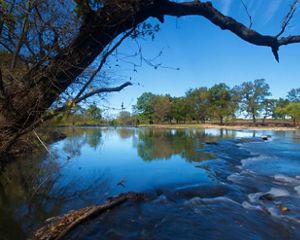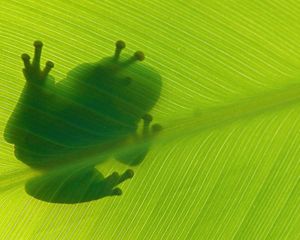Estimated read time: 7 minutes
Key Takeaway
The Nature Conservancy planted 4,001 native trees at the Oka' Yanahli Preserve to restore streams and wetlands that feed the Blue River—the first project of its kind for TNC and the OK Dept. of Transportation. The Blue River, one of only two in Oklahoma unimpeded by dams, is the water source for more than 150,000 people and contributes $928 million to $1.7 billion in ecosystem benefits each year.
At first glance, it appears thousands of great white egrets or maybe flocks of snow geese have dropped into the tall green meadows along the Blue River, but in the greenhouse-like humidity of a south-central Oklahoma summer, that’s not likely.
Instead, the view through binoculars shows unnatural white structures, standing erect, concentrated most heavily near the river with ranks that snake up to hillside stands of timber. Like sentinels in sinuous formation trailing through the tall grass, 4,001 white perforated tubes guard the river’s future, rooted inside.
The tubes are, for now, the immediately visible indicator of what The Nature Conservancy (TNC) Blue River restoration project is all about. They guard a variety of 14 native trees and shrubs like bur oak, cottonwood, American sycamore, Eastern redbud, buttonbush, and false indigo that for now peek through the tube tops and perforations but will grow to solidify a project destined for wide impact.
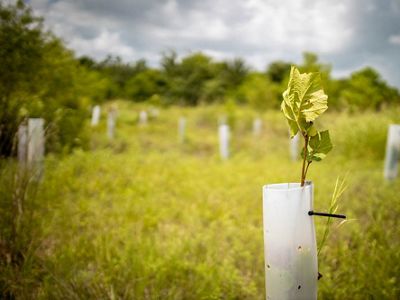
Their formations show the future of restored critical stream sinuosity—or the winding squiggles that flowing water paints on the land. Carefully engineered grades, curves, riffles and pools, the wetland features that hold, soak, filter and guide rainfall from the green hills to the river, hang on the future of these anchors. The trees and shrubs and their offspring, plus native species waiting in the existing seed bank, are poised to make a transformation.
Like a person who has found a way to defeat the source of an unhealthy habit or damaging diet, this piece of land is meant to become a replenishing, nourishing acreage not just for the waters of the Blue River but for the land, all living things in this place over the Arbuckle-Simpson Aquifer, and for people who come to witness the transformation.
Unchecked soil erosion and stream sedimentation will slow, soil health will improve, and the landscape will thrive with more life, from deer, Northern bobwhites, Prothonotary warblers, bobcats, wild turkeys and bald eagles to fish, freshwater invertebrates and microorganisms. It will grow more resilient to a changing climate and stand stronger against flooding, drought and heat.
“Look across here and just imagine it in 10 or 15 or even 50 years, as these trees grow,” says Mike Fuhr, state director for The Nature Conservancy in Oklahoma. “We are essentially trying to give Mother Nature a head start helping the trees grow instead of waiting for them to come back only from seeds spread by birds and other wildlife.”


Clear, Flowing Waters
Oka’ Yanahli, the Chickasaw word for flowing waters, is the name of the 3,598-acre preserve along the banks of the Blue River, which is one of TNC’s five priority Oklahoma watersheds. TNC, the Chickasaw Nation and private donors teamed up to purchase the initial 3,108 acres in 2011.
As one of only two Oklahoma rivers that remain unimpeded by dams, the Blue River is both a rare, sparkling jewel and a vital breadbasket. It supports agriculture, manufacturing, tourism and recreation and is a water source for more than 150,000 people in cities like Ada, Sulphur and Durant.
TNC turned to a budding field of study called ecosystem economics which calculates the value of a river in terms of cultural, natural and physical values, says Fuhr.
“It helps us gain a better understanding of the relationship between a healthy environment, a resilient economy and a thriving community,” says Fuhr. “We found that the natural capital or the dollar value of the Blue River watershed contributes $928 million to $1.7 billion in ecosystem benefits each year.”
Quote: Mike Fuhr
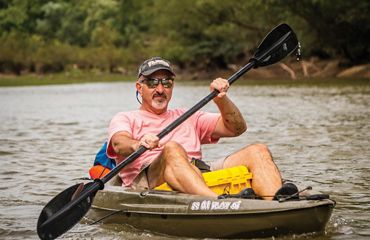
The dollar value of the Blue River watershed contributes $928 million to $1.7 billion in ecosystem benefits each year.
Fuhr and Chickasaw Nation Director of Natural Resources Kris Patton found a spot to admire the restoration project on a hillside that offered a welcomed breeze on a humid early summer day, not long after a heavy rain. From this viewpoint the winding paths marked by the white tubes between them, and the river brought the full scope of the sinuosity involved into perspective. A low bank above them indicated what used to be a pond dam from a former cattle ranch on what’s known as the “Oka’ East” side of the preserve.
This location likely was a damp spot below a pond populated with cattle standing belly deep in the waters to stay cool in years past. But on this day, they stood below a shallow embankment with a wetland developing behind it. Tall willows that recently found new life bent in the light breeze behind them and crystal-clear water flowed in a stream past their boots.
“I think the clearness of your water tells the story right here,” says Patton, as he admired the relatively deep bend in the new, winding stream. Below the water’s surface grains of sand and pebbles sparkled clearly as if they sat atop a mirror.
This was a feature returned to the landscape through no small effort. Like many acreages across Oklahoma the history of this area traces to the late 1800s, when European settlers began clearing forest in favor of land for crops and grazing. As time passed, equipment improved, and market needs increased which left the remaining trees in many areas populating only the least favorable lands.
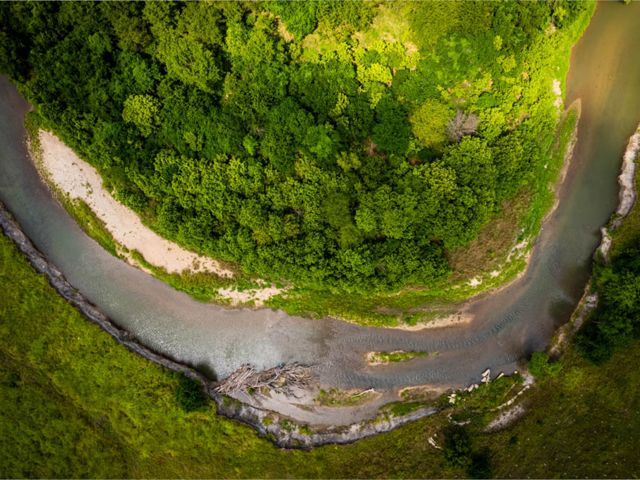
People did what they needed to do to survive and raise their families, but winding woodland streams and seasonal wetlands faded into memory, replaced with straightened channels or seasonally damp spots in pastures where ghosts of old streams appeared only during heavy rains as muddy rivulets trailing toward the Blue. These diverse prairies were planted with exotic grasses for haying and cattle ranching.
The Blue River now turns brown during heavy rains and it carves steep muddy banks where riparian zone protection is scant. Century-old trees that once made up this protective, riparian zone are now undermined and topple helplessly into the current.
But even after several days of heavy rain, the water ran crystal clear in all three winding streams now reclaimed on Oka’ East at the restoration site. Patton says this was what he hoped to see. If rains turned the river brown with mud the source was not this property.
“Our missions are aligned for conservation and for restoring wetlands,” says Patton. “This project could become a key focal point for the whole Blue River area as a model for landowners. We can say, ‘Here’s what TNC is doing on the ground. We can take you out there and they can show you how they did it and we can work with you to develop your own strategies and find funding to help you do these kinds of projects on your own property.’”
Fast Facts about the Blue River Watershed
-

141
The Blue River runs 141 miles long to meet the Red River
-

520
The entire watershed encompasses 520 square miles
-

82
Freshwater fish & 23 mussel species are found in the river
Profitable Partnerships
Completed in three phases from 2018 to 2021, the full extent of this restoration project likely falls beyond the scope of most landowners, but Patton says the model provides the pieces and parts that will show different landowners with different challenges just what can be accomplished with help and guidance from organizations like TNC.
While mornings on Oka’ East now carry the songs of dickcissels, tufted titmice and Northern cardinals, and raccoon tracks line the wetland areas, two years ago it was for a short time a rumbling landscape inhabited by what Fuhr called “huge yellow beasts.”
He chuckled at the memory of a phone call from a concerned resident who wanted to make sure TNC had not decided to turn their favorite preserve into a quarry.
It was a mining operation, in a sense, as historic survey maps from 1871 and 1899 were consulted, and aerial photos were used to determine a layout and re-carve the historic routes of the three winding feeder creeks along this section of the Blue River.
More than $3 million in mitigation funds were approved to create this restoration project under a U.S. Army Corps of Engineers permit. The Corps in Oklahoma requires mitigation for impacts to streams and wetlands on a linear-foot and acre-to-acre basis for necessary construction projects within a given drainage or watershed.


With needed overpass work and other highway improvements planned for the area, the opportunity arose for TNC’s first cooperative project with the Oklahoma Department of Transportation (ODOT).
More than 4,800 linear feet of stream enhancement, 5,300 linear feet of stream restoration, and nearly 12 acres of wetlands restoration are included. The 28-acre project total scarcely reflects the wider impact across the breadth of three creek drainages and riverfront involved.
Jerod Bechtol, an environmental programs manager for ODOT, looked over the project from the same headwaters spot where Fuhr and Patton stood earlier and said what would come naturally to any onlooker. “This already looks really impressive.”
His division contracts with consultants who will inspect the project two or three times a year and examine it under several metrics, including a percentage survival of those 4,001 trees and shrubs.
They will do well to keep up with Oka’ Yanahli Preserve Manager Jeanine Lackey, who patrols the area regularly, shovel, loppers and hammer at-the-ready to remove pesky invasive plants like waxy-leaf privet and Eastern redcedar, or to set straight the occasional saplings or staked tubes hit by flooding debris or disturbed by wildlife.
Hundreds, probably thousands, of privet and red cedar have fallen to loppers wielded by her and her small staff and the volunteer crews who organized to erect all those tubes and stakes in a matter of a few days in the fall of 2020.
Not every mitigation project has the kind of volunteer help at-the-ready or on-site staffing like the Oka’ Yanahli Preserve, Bechtol said.


To complete the long-term restoration of the acreage, TNC plans to design and implement the removal of the remaining exotic pasture/hay fields and replace with highly diverse native grass and forbs. Diversity of native grass and flowers promotes diverse soil structure, which attracts more soil microbes, helping to keep the soil intact, reducing erosion, and promoting water quality.
“This is one of those projects that is a win-win,” he says. “There are metrics that a project has to meet but everyone understands it’s a natural environment and a lot of common sense comes into play. You go out and make sure that the trees are looking good but obviously you’re not going to count 4,001 trees every time. You go out and you see that the project is functioning. Right now, this is looking very good, very, very good.”
Support River Conservation in Oklahoma
Show your Okie pride by sporting a speciality license plate on your car or make a donation to continue conservation efforts across the prairie.
